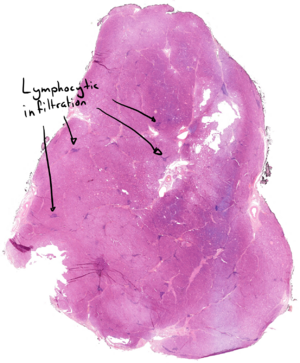27. Graves disease
Staining: HE
Organ: Thyroid
Description:
Normal thyroid follicles are replaced by two types of abnormal follicles:
- Hypertrophic follicles
- Follicles with resorption vacuoles
The follicular cells of the hypertrophic follicles are hypertrophic (large). These follicles have no visible lumen or colloid substance.
Due to the hyperactivity of the thyroid follicular cells these cells will quickly consume colloid. This leaves behind small “vacuoles” that line the follicular cells. It looks like the follicular cells “take a bite” out of the colloid substance.
As Graves disease is an autoimmune disease, which by definition are chronic, lymphocytic infiltration is present as well.
Diagnosis: Graves disease
Risk factors:
- Young females
Theory:
Nothing special.




